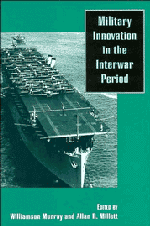Book contents
- Frontmatter
- Contents
- Acknowledgments
- Introduction
- 1 Armored warfare: The British, French, and German experiences
- 2 Assault from the sea: The development of amphibious warfare between the wars – the American, British, and Japanese experiences
- 3 Strategic bombing: The British, American, and German experiences
- 4 Close air support: The German, British, and American experiences, 1918–1941
- 5 Adopting the aircraft carrier: The British, American, and Japanese case studies
- 6 Innovation ignored: The submarine problem – Germany, Britain, and the United States, 1919–1939
- 7 From radio to radar: Interwar military adaptation to technological change in Germany, the United Kingdom, and the United States
- 8 Innovation: Past and future
- 9 Patterns of military innovation in the interwar period
- 10 Military innovation in peacetime
- Index
9 - Patterns of military innovation in the interwar period
Published online by Cambridge University Press: 05 August 2012
- Frontmatter
- Contents
- Acknowledgments
- Introduction
- 1 Armored warfare: The British, French, and German experiences
- 2 Assault from the sea: The development of amphibious warfare between the wars – the American, British, and Japanese experiences
- 3 Strategic bombing: The British, American, and German experiences
- 4 Close air support: The German, British, and American experiences, 1918–1941
- 5 Adopting the aircraft carrier: The British, American, and Japanese case studies
- 6 Innovation ignored: The submarine problem – Germany, Britain, and the United States, 1919–1939
- 7 From radio to radar: Interwar military adaptation to technological change in Germany, the United Kingdom, and the United States
- 8 Innovation: Past and future
- 9 Patterns of military innovation in the interwar period
- 10 Military innovation in peacetime
- Index
Summary
Agitated by the American treatment of Japanese immigrants in 1907, the diplomats of Nihon Teikoku fired off a series of protests, and Theodore Roosevelt volleyed back in even more bellicose language. Before the diplomatic climate improved, the United States and Japan had survived their first war scare, and Roosevelt had sent a “Great White Fleet” of sixteen battleships on a leisurely round-the-world cruise. In the Philippines, the likely theater for a war with Japan, a new ensign in the U.S. Navy, Chester W. Nimitz, took command of the coal burning, 92-foot island gunboat Panay, most noted for its low speed, lack of electricity, and sluggish handling. Nimitz could not have imagined that his modest command would become the focus of an international incident with Japan thirty years later, nor that thirty-seven years later as commander-in-chief Pacific Fleet he would destroy the Imperial Japanese Navy with his own fleet of seventeen fleet carriers, six fast battleships, and more than 800 other warships, submarines, amphibious ships, and service vessels.
In the same year the Quartermaster Department of the U.S. Army tested twelve automobiles for military missions and reported that they were unsatisfactory to replace “the standard means of army transportation.” The army of 1907, which numbered only 64,000 officers and men of its statutory strength of 88,000, had thirty regiments of infantry, fifteen of cavalry, and thirty batteries of field artillery that moved by foot and hoof, all standard means, and 126 companies of coastal artillery that didn't move at all.
- Type
- Chapter
- Information
- Military Innovation in the Interwar Period , pp. 329 - 368Publisher: Cambridge University PressPrint publication year: 1996
- 6
- Cited by

